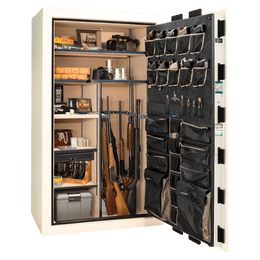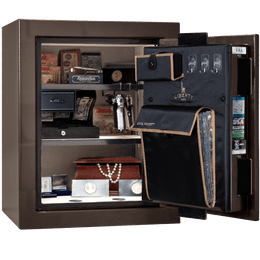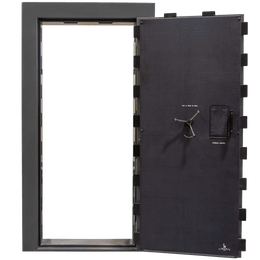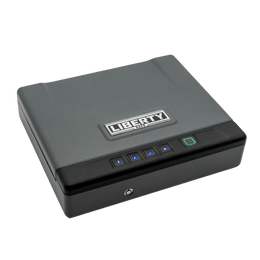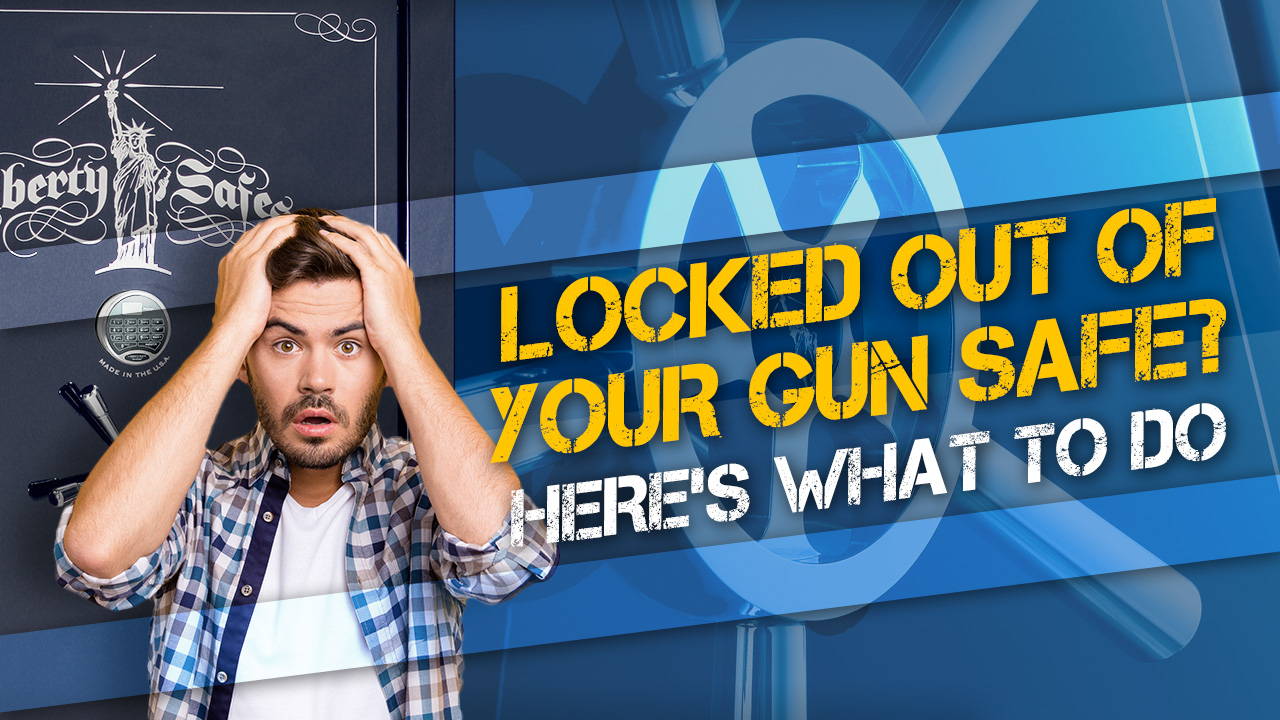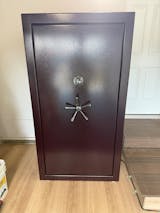If you’re like us, you may still have the occasional nightmare about forgetting the combination to your middle-school locker. It’s stressful and scary, but then you wake up and everything is okay. Unfortunately, there’s a similar situation that happens to many gun safe owners at least once in their lifetimes: Being locked out of their safe.
It’s frustrating, scary, and nerve-racking, but getting locked out of your gun safe doesn’t have to be a disaster if you stay calm and follow the tips we’re going to provide in this article. Also, don’t feel bad if you get locked out of your safe. It happens to the best of us. Let’s go over some reasons you might get locked out of your safe, and then we’ll talk about some things to try before you call a professional locksmith. (Pro tip: if you have a Liberty safe, call us first.)
Reasons you may be locked out of your gun safe and how to fix them
Believe it or not, many people get locked out of their safes, either for a few minutes, a few hours, or until they call a licensed, qualified safe expert or locksmith to help them open it. There are a lot of silly articles on the internet promising that you can open your gun safe without calling a locksmith, but in general, these articles are usually full of incorrect, irrelevant, and/or potentially harmful advice. For example, you should never break out a hammer and chisel and try to open your safe, or drill any holes in it, particularly if you value it and want it to last.
Depending on the type, manufacturer, design, and age of your safe, there are a few potential reasons why you may be locked out of your safe. Let’s go over some of the most common.
Lost keys
This is very common for owners of key-locked safes, lock boxes, gun cabinets, handgun vaults, and similar storage devices. Obviously, a key-locking safe is only secure if it’s locked, and it’s only convenient if you keep the key in a safe place, but somewhere you can access it when you need to. Many times, owners will hide their key in a location where they think they’ll easily remember, but after a few weeks or months, it slips their minds. Or they may keep their key on a key ring with their car or house keys, and then misplace the entire key ring.
Forgot the combination to a mechanical dial safe lock
Just like in middle school, you need to remember the combination of your safe’s mechanical dial lock, and depending on how often you open it and how good your memory is, it can slip your mind.
You may also have a combination dial that has a keyed lock to secure the dial itself, to prevent people from trying to open the safe. If you remember the combination, but you forgot where you put your key and the dial is locked, you’re in a bit of a pickle.
The digital keypad is not working (or you forgot the code)
The electronic/digital keypad on some safes can potentially fail, as can all electronic devices. Generally, they are very reliable, but nothing is flawless. On some handgun vaults or smaller safes, they may not have a numeric keypad but rather a series of buttons or plungers that you must press in a specific order or a specified number of times. These also can theoretically become worn or otherwise fail.
By far the most common way people get locked out of their gun safes with digital combination keypads is they either forget to try installing a new battery, forget the entry code, or forget that they have changed the code to a new one. Yes, we have done this.
Can you open a gun safe without keys?
Depending on what kind of keyed-lock safe you have, the answer here is both yes and no. ANY safe can be opened without keys, if you have enough time and the right tools. You’ll likely destroy the lock and/or safe in the process, but it’s doable. The really relevant question you should be asking is not whether you CAN open a gun safe without the key, but SHOULD you. Some cheaper safes and gun cabinets with keyed locks can be easily picked by someone who knows what they’re doing, or in some cases, even by screwdrivers, butter knives, or similar tools. Obviously, this level of security is not ideal for storing firearms, but some people choose to employ this type of storage device for various reasons.
If you have a cheaper keyed locking device on your gun safe, and can’t find the key, we’d recommend you first contact a locksmith, unless it’s not economically feasible. If you pick, drill, or force the lock and get your gun safe open, we recommend learning from your mistake and investing in a better safe from Liberty with a more secure lock, and taking more precautions against losing your key/combination in the future. After all, if you can get into your safe without using the key, so can someone else.
How to get into your gun safe if you’re locked out (some things to try)
So, if you find you can’t get into your gun safe, don’t panic. Here are some things to try (and NOT to try) first, before you call a locksmith or your safe company.
- Change the battery. If your safe has an electronic or digital lock, the first thing you should do is change the battery. This is usually very simple and you should be doing it every 6 to 12 months anyway. If you’re not sure how, check your manual, or call the manufacturer if you need help. Even if you've changed the battery within the past few weeks, buy a new, fresh battery and install it. Sometimes the mechanism that moves the locking bolt can become sticky or worn, particularly if you haven’t had the safe cleaned and maintained, and a fresh, new battery can help provide the extra power it needs to click into the right place.
Also, don’t worry about your entry code being “forgotten” if you remove the battery or it’s completely dead. Electronic locks store codes in what is called “non-volatile memory” that holds onto the combination codes that you have programmed into your lock. In fact, your electronic lock’s memory can retain your codes for up to 10 years after your battery is dead or removed.
- Reset to factory settings. Another thing to try if you have a digital keypad is to try resetting the keypad to factory settings. Depending on your safe’s manufacturer, you may have been provided a card with a master entry code, or there may be instructions included in your manual for resetting your digital keypad to factory settings that may open your safe in an emergency. Of course, this only works if your manual/card isn't locked inside the safe, and if your type of lock allows this action.
- Wait half an hour and try again. Many digital keypad safes have an automatic lockout feature if someone tries to enter the wrong code too many times. If you’ve entered a code several times and it’s still not working, avoid entering it again until you’ve waited at least half an hour. If it still doesn’t open and you’re absolutely sure you’re entering the correct code, try tip #1 (above) if you haven’t already done so.
- DO NOT try to force the handle to make the safe open. You may be tempted in your frustration to try to forcibly turn the safe’s handle to open the safe. Don’t do it. On most quality safes, the handles are specifically designed to “strip” or break away to prevent forcible entry. All you’ll do is cause damage.
- Take a break to calm down and think. This may seem like a silly tip, but it works in a lot of cases. Calm down, go do something else for a while, and try really hard to remember if you've changed the combination recently (or, in the case where you’ve misplaced your key, think about all the places you might have stored it). We've had several occasions where people changed/updated their entry code to a new one and then forgot that they did it, and tried to use their old code to get into their safe. If you change your code on a regular basis, and you remember or have a list of your codes, try your previous two codes. Allow time in between attempts so the automatic lockout feature doesn't activate.
- Try using a hair dryer on mechanical dial locks to warm it up. Sometimes old lubricating oil can congeal or oxidize and harden, sticking tumblers in place. Warming it up can sometimes help. Don’t use a heat gun or any sort of torch or flame. Just use a hair dryer, and of course, be aware that the dial will get quite warm to the touch. If this tip works and you get your safe open, be sure to have your safe’s mechanism professionally cleaned and lubricated before you lock it again.
- If your safe is keyed, use your backup key. Think hard about whether you made or hid a backup key somewhere when you first got your safe. Sometimes people forget that they had a spare key made, or that their safe came with an extra set of keys.
- When all else fails, call a professional. If you have a Liberty safe, the first thing you should do is call customer support if you find you’re locked out of your safe. We will be happy to assist you in any way we can, and have helped a lot of people get into their Liberty safes. If you don’t yet own a Liberty safe, consider calling a local, licensed safe professional or locksmith. It will cost a little money, but usually less than the damage you can cause by trying to open your safe yourself when you’re locked out.
- Regularly maintain your gun safe and have a backup plan to prevent lockouts. Finally, have your safe inspected and professionally serviced at least once every 5 years, and more often if you use it frequently. Write down your combination in a secure location, and make a backup key and store it somewhere you won’t forget.
Buy a Liberty Safe and we will provide support if you are locked out of your safe
Along with your lifetime warranty, when you buy a USA-made Liberty safe, you get our top-rated customer service as well. If for any reason you find you can’t get into your Liberty safe, call us and we’ll do everything we can to help you get it open.


